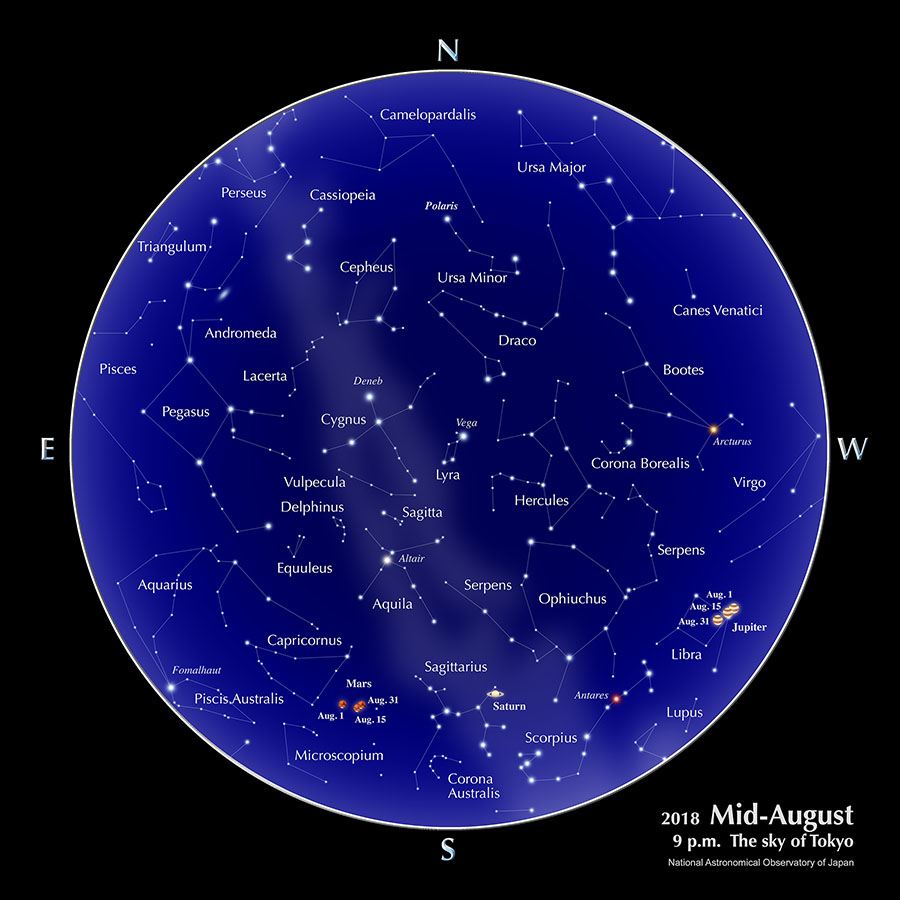The sky of Tokyo, Calendar, Planets (August, 2018)
The sky of Tokyo

Calendar (August)
| 5 | Last Quarter Moon |
| 8 | Uranus at stationary point |
| 9 | Mercury at inferior conjunction |
| 11 | Mountain Day [Yama-no-hi](national holiday) / New Moon / Partial Solar Eclipse (not visible from Japan) (Reference: Local Prediction of the Solar Eclipse) |
| 13 | The Perseid Meteor Shower peaks around 10:00. (The best time for viewing is before dawn on the 13th. On the order of 40 meteors per hour are expected. Conditions are good.) |
| 17 | Traditional tanabata (traditional star festival) |
| 18 | First Quarter Moon / Greatest Eastern Elongation of Venus / Mercury at stationary point |
| 26 | Full Moon |
| 27 | Greatest Eastern Elongation of Mercury |
| 28 | Mars at stationary point |
The days for the peak activities of the meteor showers are based on the predictions of IMO(International Meteor Organization).
Planets
- Mercury
- Mercury reaches inferior conjunction on August 9. From the beginning to the middle of the month, its position is close to the Sun, making observation difficult. Mercury reaches its greatest western elongation on August 27, so it can be easily obsereved in the lower eastern sky around the 27th. As seen from Tokyo from August 25 to August 31, its elevation exceeds 10 degrees at 30 minutes before sunrise. Its brightness is 0.2 magnitude to -0.7 magnitude from August 25 to August 31.
- Venus
- Bright Venus is low in the western to southwestern sky after sunset. It reaches its greatest eastern elongation on August 18. Its brightness is -4.2 magnitude to -4.4 magnitude.
- Mars
- Mars moves west (retrograde motion) in the constellation Capricornus. After passing the stationary point on August 28, it moves to the east (direct motion). It skims the constellation Sagittarius around the stationary point. At the stationary point, Mars seems to stop with respect to the stars. Seen from Tokyo in the middle of August, it rises before 6 p.m. In the end of August, it reaches culmination around 10 p.m. Its brightness is -2.8 magnitude to -2.1 magnitude.
- Jupiter
- Jupiter moves east (direct motion) in the constellation Libra. It can be seen after sunset in the southwestern sky. Its brightness is -2.1 magnitude to -1.9 magnitude.
- Saturn
- Saturn moves west (retrograde motion) in the constellation Sagittarius. It can be seen after sunset in the southern sky. Its brightness is 0.2 magnitude to 0.4 magnitude. It still is a good time to observe Saturn.
Reference: Ephemeris Computation Office, NAOJ
With the “Sky Viewer” you can easily explore the appearance of a typical urban night sky (planets and constellations are visible). The Celestial Phenomena section of the glossary explains the planetary phenomena terms: greatest elongation, opposition, conjunction, stationary, etc.